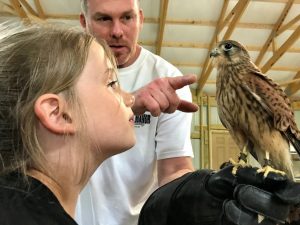
You never know where you’ll see great teaching in action. That was made abundantly clear to me when my family ventured to rural Lillington, North Carolina to learn about falconry, civilization’s oldest form of hunting. We are not hunters ourselves, but my husband is fascinated by birds of prey and we thought our girls, ages four and eight, would learn a thing or two about these impressive animals. While I expected it to be an engaging learning experience for kids and adults alike, I was blown away by the level of master teaching delivered by owner Chip Gentry of Hawk Manor Falconry. His audience was diverse- about 15 people ages four to 60 including a family from Finland. He managed to keep us all engaged for a nearly three-hour lesson delivering much more advanced content about these birds than I ever expected.
How did he do it? As a former public school teacher, I know there are many markers of exceptional teaching, but I want to point out four strong practices demonstrated by Mr. Gentry.
- Learner led, inquiry based
Mr. Gentry opened up the lesson by asking the audience two questions. What do you already know about falconry? What do you want to know about falconry? He had a well-planned lesson prepared, but instead of diving right in, he checked the prior knowledge of his students and let our natural curiosity dictate his starting point. Were our questions out of his logical order? Probably. But when my four-year-old asked, “Why don’t birds have arms?” he answered it with just as much zeal as any other question and made her feel like that was very important to explore. He still got through all of his content, but this approach led the learners to feel they were guiding the lesson, thus giving us deeper ownership and engagement with the material.
- Cross-curricular
Mr. Gentry covered a lot of ground to help us learn about birds of prey and falconry. The content cut across disciplines, helping learners make deeper connections solidifying the importance of these animals. First, there was a history lesson about the ancient use of falcons for hunting in the Middle East and as a status symbol by royalty in Great Britain and Europe. There was a deep biology lesson about the birds’ physiology, evolution, diet and metabolism. There was a political lesson about the government regulations protecting the birds and policing their use for sport and abatement work. There was also a math lesson about the importance of regulating their food supply as a training tool, which got down to daily tracking of weight by the half ounce by use of scales and feeling their breastbones. They won’t hunt if they’re not hungry, but they can’t get too depleted.
- Standards-based
Even though adults walked away with extremely detailed knowledge and understanding, there were simpler standards that grounded the lesson for the children. If educational standards are the floor for what all learners needed to know, then they had to be appropriate for the “lower level” of the young children in the audience. The essential standards were the four classification traits that separate birds of prey from all other birds: forward facing eyes for hunting; hooked beaks for ripping meat off of bones; talons that are strong enough to strangle prey and sensitive enough to feel when their heartbeat stops; and the fact that they only eat meat. We got hands on with two different hawks, one falcon, one owl, and one vulture. While we learned much more about each of their unique attributes, Mr. Gentry always brought the kids back to identifying if the four key traits existed to make them raptors. He re-assessed the class five times to make sure these standards were learned.
- Multi-modal
All teachers know that students have different learning styles (visual, auditory, kinesthetic), and we try to create lessons and activities that appeal to the different learning modalities. But it doesn’t always happen in every lesson. Mr. Gentry nailed this one. Obviously working with live animals lends itself to the kinesthetic learners as we were able to move around, get hands on, and perform training activities with the birds. But even for the first 30-minute “classroom” history and political lesson, he wove in photographs, props and videos for the visual and auditory learners. It was dynamic and kept the attention of preschoolers through adults.
Chip Gentry is a certified Master Falconer holding four additional national licenses, one of which allows him to teach college courses on the subject. He also happens to be married to a Kindergarten teacher. I wonder if this combination helped him master the art of differentiation to make sure adults received advanced instruction while not leaving the little ones behind. This experience reminded me that this type of master teaching is possible and needs to be more widely practiced in K-12 classrooms to keep students engaged and learning at higher levels. It was a refreshing lesson from an unexpected teacher.

2 Comments
what a lovely story and wonderful application of effective teaching and learning. nice job nadja!
Thanks, Michael! I owe it all to you as you first told me about falconry 5+ years ago. We finally got around to it and it was a wonderful learning experience for our family.